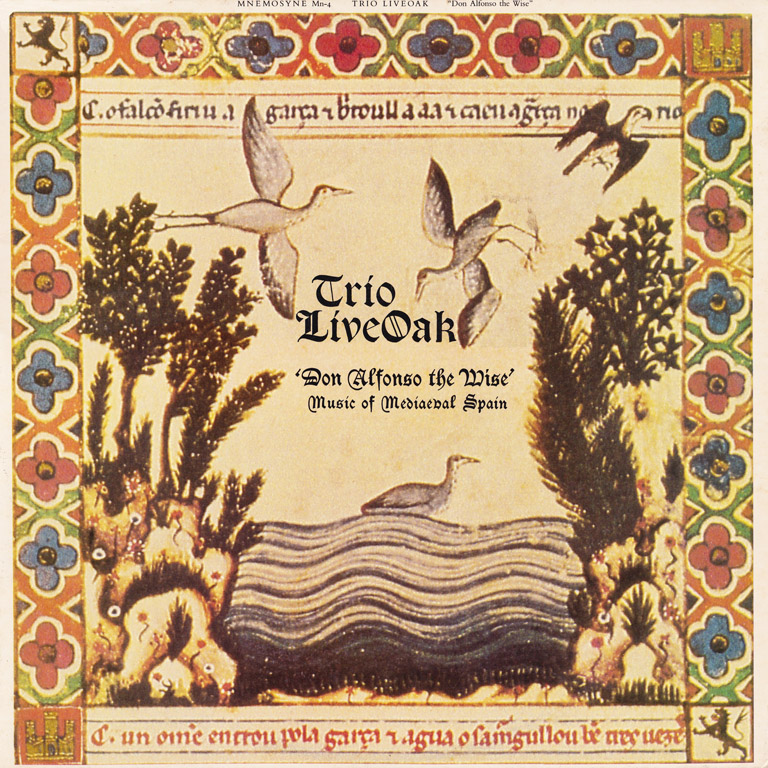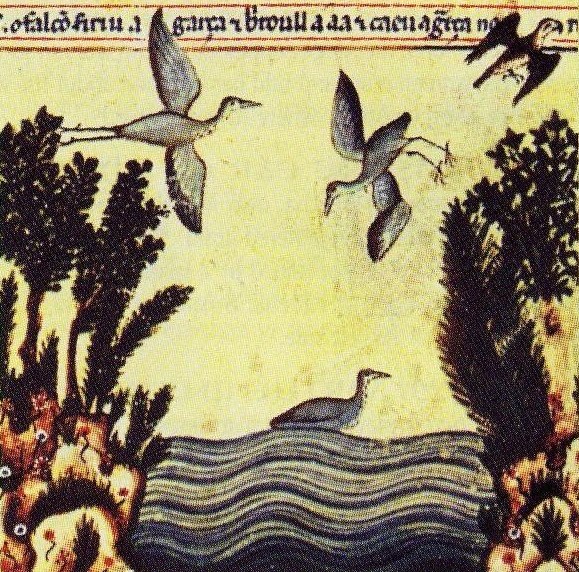Don Alfonso the Wise / Trio Live Oak
Music of Mediæval Spain

medieval.org
worldcat.org |
amazon.com
Mnemosyne Mn-4
1983
SIDE A [24:57]
1. Sanctus. Cleri cetus [3:52]
Hu 14
Ms. de Las Huelgas —
NK, solo voice; JF & FW, vocal duet | recorder, rebec, gittern
2. De castitatis thalamo [0:57]
Hu 145
Ms. de Las Huelgas —
JF & FW, vocal duet | finger cymbals
3. Maria, virgo virginum [3:30]
Hu 52
Ms. de Las Huelgas —
NK, solo voice; voices | psaltery, rebec, gittern
4. S'ieu ia trobat non agues [2:46]
Guiraut RIQUIER | Ms. R —
JF, solo voice | flute, gittern, percussion
5. Nenbressete, Madre de Deus [7:19]
CSM 421
Cantiga de Santa María, Ms. B.i.2 de El Escorial —
NK, solo voice | JF, rebec
6. Santa Maria amar devemos [6:33]
CSM 7
Cantiga de Santa María, Ms. B.i.2 de El Escorial —
FW, solo voice; voices | gittern (JF), flute
SIDE B [24:08]
1. A l'entrada del tens clar [3:00]
Anonymous, Chansonnier de St. Germain —
JF, solo voice; voices | vielle, gittern
2. [2:39]
Muito bon miragr' a Virgen
CSM 225
Quen quer que na Virgen fia
CSM 167
Cantigas de Santa María, Ms. B.i.2 de El Escorial — gaita, flute, tambourine
3. Be'm degra de chantar tener [5:58]
Guiraut RIQUIER | Ms. R |
melody: Tant mes plazens
FW, solo voice; voices | gittern, psaltery, flute
4. Amor vincens omnia ~ Marie preconio ~ Aptatur [1:40]
Hu 127
Ms. de Las Huelgas — vocal trio | vihuela de arco
5. [2:55]
Splendidus regis ~ Leo, bos et aquila ~ Kyrie —
Ms. de Las Huelgas
Hu 92
Vellut stellæ ~ Hypocritæ ~ Et gaudebit —
Codex Bamberg
JF, solo voice; voices | rebec, gittern, vihuela de arco
6. Royne Celestre [7:56]
Gautier de COINCI | Bruxelles, Bibl. Roy. 10.747
NK, solo voice | FW, gittern; tar
Recorded in November 1982 in the Great Hall of the Hammond Castle
Museum in Gloucester, Massachusetts.
Special thanks to the museum for
its help and cooperation.
Recording engineer and production director: Ralph Dopmeyer
Jacket design and typography: Philidor Press, Boston
Cover illustration: miniature from Cantiga 142 (Las Cantigas de Santa Maria, Ms. T.i. 1 de El Escorial)
Photograph: Clemens Kalischer
Mnemosyne Records is a division of Titanic Records, 43 Rice Street, Cambridge, Massachusetts 02140.
JACKET MADE IN CANADA
P & C 1983, Titanic Records
℗ & © 1983, Titanic Records

TRIO LIVEOAK
JOHN FLEAGLE — tenor, rebec, vielle, gaita, psaltery, gittern, percussion
NANCY KNOWLES — soprano, flutes, psaltery, vihuela de arco
FRANK WALLACE — baritone, gittern, vihuela de arco
Trio
LiveOak, founded in Boston in 1976, is composed of three highly
skilled singers and instrumentalists. Having come from various musical
backgrounds, ranging from classical guitar to jazz string bass and folk
fiddle, these three musicians studied early music performance with
Marleen Montgomery, and vocal technique with Marcy Lindheimer.
The
trio first toured Europe in 1979 (“LiveOak is on the move!” The
International Herald Tribune); during subsequent European tours, it
performed in the IV Festival de Música Antiga de Barcelona, XX Festival
de Música Religiosa de Cuenca, XIII Semana de Música de Cámara de
Segovia, and the Utrecht Early Music Festival (part of the Holland
Festival). The group, a member of the New England Touring Program,
performs regularly in New England as well as throughout the United
States. Live Oak made its Carnegie Recital Hall debut in 1981, and has
two previous recordings: LiveOak Live (Encina 2037) and
Star Shining on the Mountain (Mnemosyne Mn-2).
LiveOak takes its name from the non-deciduous oak, a symbol of
revitalization. Edward Rothstein of The New York Times wrote about the
group, “In music of the 13th century, the trio lived up to its name. . . .
The players and singers not only revitalized the 700-year-old music, but
they also gave it a youthful suppleness and mature solidity. . . . The
eloquence of the players could not have been improved upon. . . This was
not historical excavation; the trio presented a thriving musical
organism.”
THE INSTRUMENTS
gittern, psaltery, and rebec — John Fleagle
vihuela de arco — Peter Flax Cass
vielle — Bernard Lehmann
flutes — Deba Prosad Banerjee, John Ingalls, and James Bartram
gaita — Joel Robinson

THE MUSIC of thirteenth-century Europe reflects a time of
extensive change and contrast. The simple, rounded lines of Romanesque
architecture were replaced by the fierce, brilliant architecture of the
Gothic style, challenging the limits of thirteenth-century physics and
mathematics in a dizzying heavenward thrust. Europe's earliest
universities were born, among them the Sorbonne, which grew up around
the great Notre Dame Cathedral in Paris. Marco Polo traversed the known
world, bringing back tales from the mysterious East.
In
the world of music, the Paris composers Leonin and Perotin paved the
way for new musical forms like the motet, which would bring secular and
religious factions into sharp contrast. The motet Vellut
stellæ/Hypocritæ/Et gaudebit best illustrates the state of affairs
with its contradictory texts to be sung at the same time: one extolls
the virtues of the prelates of the church; while the other berates them
for their hypocrisy, their decadence, and their “boozy orgies.” The
mediæval motet (French mot = word) was based on a rhythmic modification
of church plainsong over which new melody and text were composed. The
texts were either sacred or secular. This very concept reveals the
subtle but deep undermining of the mediæval church and its hold on
society.
Not all forms of
secularization were so devastating; the secular and religious worlds
were sometimes brought together in the use of new and popular forms for a
pious message. Such was the recounting of miracles attributed to the
divine influence of Holy Mary, which provided countless hours of
entertainment in courts and monasteries, and along the pilgrimage routes
of mediæval Europe. Stories of the Virgin Mary were plentiful. Gautier
de Coinci (c. 1177-1236), a monk at St. Medard de Soissons, spoke of
“an embarrassment of riches” in selecting material for his collection of
Miracles de Notre Dame.
On
the faith of my soul, so many pleasing miracles of Our Lady do I find
written that I know not the which to choose . . . even as he who seeks
flowers and who sees all around him so many diverse ones — crimson,
violet, yellow, and dark blue, that he knows not the which to pluck
first.
Of Gautier's works we have chosen the beautiful sequence of praise,
Royne Celestre, a song of contrasting tenderness and anguish.
Inspired
by the work of Gautier, Alfonso X “The Wise” (1221-1284), King of
Castile and Leon, compiled the Cantigas de Santa María, over 400
miracles and songs of praise to Holy Mary. In one manuscript, richly
colored miniatures, six to a page, unfold their story to the reader's
eye. In another, every tenth cantiga, being a song of praise to the
Virgin, is preceded by a miniature depicting musicians playing
instruments of the time, some of which we have used in this program: the
gittern, the psaltery, the rebec, and the gaita.
The poems, which
show a fascinating cross-section of mediæval life, are written in
Gallego-Portuguese, the preferred language for poetry. Msr. Higini
Angles, the twentieth-century editor of the Cantigas, finds a rare
insight into period performance practice in the Coronación de Reyes y
Ceremonias que en Ella Se Guardan (Codex El Escorial, sig. III, x. 3, f.
24v.). There appears in the manuscript a miniature with a description of the coronation of
Alfonso VIII of Castile. Two doncellas (young women) are holding a page
of music and singing. At their left another plays a vihuela, and at
their right two more play cymbals as the king marches to the altar to be
knighted a “Cavallero de Santiago.”
If polyphonic music was sung in Alfonso's chapel, then it probably
included repertory found in the Códice Musical del Monasterio de Santa
Maria la Real de Las Huelgas de Burgos (known as the Las Huelgas Codex).
The monastery of Las Huelgas was founded around 1187 by Alfonso VIII of
Castile and Eleanor of England and given to the Cistercian order. With
strong patronage it quickly became an important center of musical
performance and composition, as evidenced by the numerous works of one,
two, and three parts that have survived from the twelfth and thirteenth
centuries, some of which the nuns still sing there today.
Guiraut Riquier of Narbona (c. 1230-1292), called “the last of the
troubadours,” spent ten years, from about 1270 to 1280, at the court of
Alfonso X. His last poem, Be'm Degra de Chantar Tener (1292), is a
bitter recounting of the life of one who has “come too late,&lrquo; born into
an age when courtly ways were no longer observed and the art of
singing no longer respected. We have set this text to the melody of his
first canso, Tant Mes Plazens. S'ieu Ja Trobat is a tribute to his good
patron Alfonso X.
The universal themes of love and the celebration of spring are found in
the anonymous Provençal balada, A L'Entrada del Tens Clar. They are
echoed in the Norman cantilena rotunda (rondeau) spoken of by the
Parisian theorist Johannes de Grocheo (c. 1300) and in the song and
dance of the Breton Fest-noz, still a popular tradition today.
— John Fleagle




